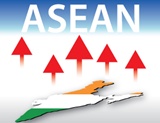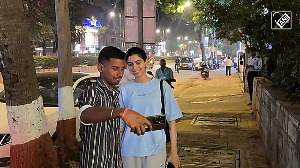
The Indo-Asean FTA provides an opportunity for India to be more engaged with the region, says Sanjaya Baru.
This is an important week for Prime Minister Manmohan Singh. Over the weekend, at the Fourth East Asia Summit in Thailand, he will witness the final fruition of the second most important foreign policy initiative he took during his first term in office - the India-Asean Free Trade Agreement.
This should ensure he will be in better mood than he was at the First East Asia Summit in December 2005, where the Malaysian host, Prime Minister Abdullah Badawi, poked fun at India's FTA negative list of 1,414 products! India's negative list is longer than what it exports, was one such taunt. The Prime Minister was livid. He left Kuala Lumpur determined to seal the deal. He returns to Thailand four years later to keep his word. But the intervening ride has not been a smooth one.
The Asean FTA was launched in October 2003 and was to be completed by July 2005. However, in April 2005, Congress party president Sonia Gandhi wrote a letter to Singh stating: "The Congress party feels that instead of opening up the agricultural and manufacturing sectors through FTAs, more effective domestic policy measures need to be adopted to protect and strengthen the growers and manufacturers in these sectors." The letter was leaked to the media by a party functionary who is now a minister.
The prime minister was constrained to defend his initiative, publicly stating: "Our approach to regional trade agreements in general, and FTAs in particular, has been evolved after careful consideration of our geo-political as well as economic interests. Although India has a large domestic market, our experience with earlier relatively insular policies, as also the global experience in this regard, clearly bring out the growth potential of trade and economic cooperation with the global economy." Careful observers in Asian capitals took note of the reference to 'geo-political' interests. Yet, the FTA was not approved by the government during its entire tenure in office.
Like the civil nuclear agreement, the Asean FTA too was an initiative Singh inherited from his predecessor, Atal Behari Vajpayee. But in both cases he had to do the political heavy lifting. While the controversies dogging the civil nuclear agreement grabbed all the headlines, the India-Asean FTA too has had its share of domestic problems. On both fronts, these problems were compounded by criticism from within the ruling Congress party.
While outside criticism of the FTA was muted, and remained largely confined to the Left Front (which recently organised a human chain across Kerala in protest against the signing of the FTA), opposition to the FTA from within the government came from three quarters. First, the domestic oilseeds lobby which was opposed to lower duties on palm oil imports. Second, domestic manufacturing interests that were mainly concerned about rules of origin and the likelihood of cheap Chinese imports making their way into India through Asean. Their view was often articulated by the chairman of the National Manufacturing Competitiveness Council and the Union minister for commerce and industry. Third, the plantation interests in Kerala, worried about cheaper rubber, coffee, tea, pepper and palm oil imports.
All these views found open expression in the meetings of the Trade and Economic Relations Committee, an institutional innovation of Prime Minister Singh that enabled the ministry of external affairs to voice its views on such matters, in opposition to the views of sectoral ministries and experts. From 2005 to 2007, the FTA was kicked around various ministries in Delhi and between Asean capitals. When India chose to soften up, Malaysia or Indonesia would play hardball. Negotiating officials became tired trying to square many circles.
Each time there was an impasse, the FTA's opponents at home would gleefully call for its burial. Each time the prime minister had to personally intervene to keep hopes alive. At one meeting of the TERC, where some senior ministers appeared to have ganged up to sabotage the FTA, an exasperated Prime Minister recalled his battles with domestic business lobbies in 1991-92 and pointedly remarked that if he had won over the so-called 'Bombay Club' then, he could win over any critic of the FTA now.
At one stage, in 2007, Kerala chief minister V S Achutanandan led a delegation that included economists Prabhat Patnaik (deputy chairman of the Kerala State Planning Board) and Thomas Isaac (state finance minister) and urged the Prime Minister to give up this initiative. With an uncharacteristic impish look and a wicked smile Manmohan Singh replied, "but these pepper and coffee imports will come from the fraternal socialist republic of Viet Nam!" The delegation guffawed in unison and left, though the Left Front is again trying to revive its fortunes through a renewed campaign against the FTA.
It took a renewed electoral mandate and new leadership in the commerce ministry for the government to finally seal the deal. The FTA in goods will now be followed up with one in services. India would like that fast-tracked to ensure balanced gains from greater integration.
The goods FTA will bring tariffs down to zero by 2016 for over 4,000 products, which is about 80 per cent of what is presently traded, and to 5 per cent for a 'sensitive list' of about 500 products. For the 'highly sensitive' commodities like black tea, coffee, crude and refined palm oil, tariffs will come down to levels of between 37.5 per cent and 50 per cent by 2019, and a negative list of 489 farm products has also been specified. It is possible that Indian industry and plantation economy will face the heat of competition. But neither is incapable of surviving the race.
Asean leaders view the FTA as India putting its money where its mouth is on its 'Look East' policy. They would like to see India more actively engaged with the region and more open to it. Even as China is admired and feared in the region, India is being wooed. In turn India must be more engaged with the region, recognising and appreciating Asean's role as a vital hub of the emerging East Asian Community.







